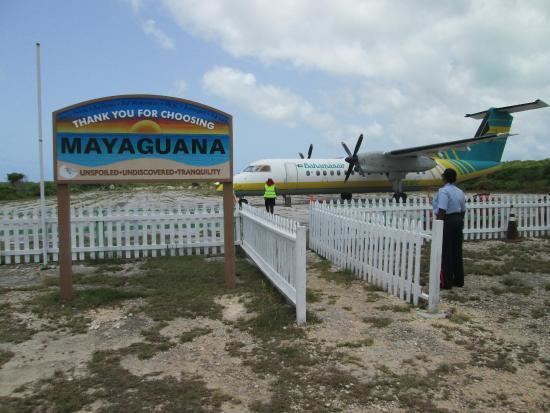Country Bahamas Time zone EST (UTC−5) Population 277 (2010) | Island Mayaguana Area 280 km² Area code 242 | |
 | ||
Bahamas film challenge 3rd place mayaguana mark drake blue movie
Mayaguana is the most easterly island and district of the Bahamas. It is one of only a few Bahamian islands which retain their Lucayan names. The population of Mayaguana in the 2010 census was 277. It has an area of about 280 km2.
Contents
- Bahamas film challenge 3rd place mayaguana mark drake blue movie
- Map of Mayaguana The Bahamas
- Bahamas 14 islands envoy film of mayaguana by mark drake
- History
- People and culture
- Environment
- Tourism
- References
Map of Mayaguana, The Bahamas
About 100 km north of Great Inagua and 560 km southeast of the capital Nassau, Mayaguana is considered the halfway point between South Florida and Puerto Rico and is about 450 nautical miles off Palm Beach, Florida. It is a popular stopover for boaters on a direct route to the eastern Caribbean. It also was one of the first islands that Christopher Columbus landed on during his journey to the new world.
Bahamas 14 islands envoy film of mayaguana by mark drake
History
Mayaguana was inhabited by Lucayans prior to the arrival of the Spanish following 1492. After the last of the Lucayans were carried off to Hispaniola by the Spanish early in the 16th century, the island remained uninhabited until 1812, when people began to migrate from the Turks and Caicos Islands, which are located about 100 km southeast.
The Brazilian historian Francisco Adolfo de Varnhagen suggested in 1824 that Mayaguana is Guanahani, the first island visited by Christopher Columbus at his discovery of the Americas. His theory has found little support. Mayaguana apparently was the Lucayan name (meaning "Lesser Midwestern Land" ) for the island.
The first steamship to circumnavigate the globe, the Royal Navy sloop HMS Driver, was wrecked on Mayaguana on 3 August 1861, 14 years after the completion of her epic voyage in 1847.
During NASA's Project Mercury and the Apollo program, the United States space program had a missile tracking station on what is now Mayaguana Airport. The station was used to help keep astronauts on course. The Mayaguana Airport was built by US Army Engineers attached to the US Air Force. The airport was built as a runway for jet planes that would follow missiles fired from Cape Canaveral. Real time sighting and photography was the best technology of the time for observing the flight of the missiles.
The Bahamian government has recently approved working with American investors MMC to turn Mayaguana into a "free trade zone," complete with tourism development of approximately 14% of the island. Actually, this is 14% of the total landmass but essentially most of the coastal region. The proposal was met with moderate resistance by Mayaguanians, who look forward to economic expansion but are unsure of what change is to come. This development is still in a planning phase and is trying to maintain the nature of the island as a quiet eco-tourist destination while still creating sustainable economic growth.
People and culture
The largest settlement is Abraham's Bay (pop. 143) on the south coast; other settlements are the neighboring towns of Betsy Bay (pop. 44) and Pirate's Well (pop. 90) in the northwest. The uninhabited areas of Upper Point (north shore), Northeast Point, and Southeast Point are largely inaccessible by road.
The least developed Bahamian island, Mayaguana has never seen major growth. It was settled gradually after 1812 by people from the Turks and Caicos. Most people make a living fishing and farming.
Considered the most isolated Bahamian island, Mayaguana uses the country's mail boat system as its primary form of communication. Mayaguana is visited once a week for delivery and pickup.
Environment
Mayaguana is known for its fertile soil, which is good for farming, and its woody terrain. Common lignum-vitae (Guaiacum officinale), holywood lignum-vitae (G. sancutm) and other hardwoods can be found throughout the island. The island is home to several government nature reserves.
As the easternmost island in the Bahamian Commonwealth, Mayaguana is bordered to its east by deep waters of the Atlantic Ocean. Many underwater coral reefs are found off-shore, as well as shipwrecks.
Mayaguana is home to the Bahamian hutia, a rodent that was thought to be extinct until the mid-1960s, as well as American flamingos, Bartsch's iguanas, plovers, terns, and osprey. Nesting sea turtles can be found throughout the undeveloped eastern part of the island. About 118 species of bird are found on the island, including two large brown booby colonies.
Tourism
As the most isolated island, Mayaguana is one of the least visited by tourists in the Bahamas. Most tourists who visit do so for the isolation, as well as scuba diving, bonefishing, snorkeling, and duck hunting. The eastern part of the island is popular with advanced off-trail bikers. Ecotourism is also a common draw.
The island is accessible by the Mayaguana Airport (MYG), which is located southeast of Abraham's Bay and is visited by Bahamasair as well as private aircraft.
